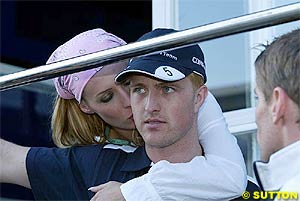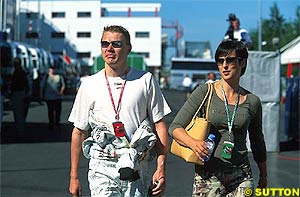
Atlas F1 Senior Writer
There is little doubt that the drivers' wives and girlfriends are a welcome sight in the Grand Prix paddock. But do the men inside the cockpit benefit from having their ladies so close? Or are they just a distraction that makes them lose their focus? Karl Ludvigsen tries to find the answer
Alfred Neubauer had a clear and pragmatic view on this. He expressed it to the board of Daimler-Benz when requesting its permission to pay the expenses of Juan Fangio's lady friend (known as "Mrs. Fangio" although she wasn't) to accompany him to the races. "We have always had the experience that, especially in case of accidents, the women are very necessary," the great German team chief said, "because they are the only ones who take care of the injured when the racing team has to up stakes and depart." There's a practical perspective for you.
In the post-war era we've had the phenomenon of the drivers' wives who took up with apparent enthusiasm and no little skill the job of timing and scoring. Among them were Patty McLaren, Bette Hill, Nina Rindt, Maria-Helena Fittipaldi, Barbro Peterson and Helen Stewart. Here, at least, was a task on which they could concentrate while their spouses were on the track during practice and the race. It kept them out of the way of the team managers and mechanics and provided a useful function.
Now, of course, timing is automated so that option doesn't exist. With that change came increased freedom of decision for drivers' ladies. Some elected not to go to the races. I don't recall Damon Hill's wife making a lot of appearances, or Nigel Mansell's. Niki Lauda? Alain Prost? Do you remember seeing their better halves at the races? It's not something that I recollect.
In contrast we have the example of Mika Hakkinen. Erja came on the scene big time. She was front and center in the garage and clearly in Mika's life as well. When he was racing, she seemed to be good for him. Dare I suggest that she must also have had a lot to do with his premature retirement? There's a lot to be said for quitting at the top. Mika sat out what proved to be an indifferent McLaren year; for that he can't be blamed. But quitting altogether at the age of 34? It's a terrible loss to the sport and, I think, to Mika Hakkinen as well. I blame Erja.
But I still have my doubts that a driver performs at his best when his lady is around. Some team chiefs take this partner issue into account. Sir Frank Williams brought it up in connection with Ralf Schumacher's apparent inability to make the second halves of his seasons match up to the first. "Maybe it was due to the distraction of being engaged," he said, "and now this year having a baby." Frank has enough knowledge of the vicissitudes of the lives of his drivers to be able to make such a suggestion with the benefit of experience.
Of course Ralf then flummoxed both Frank and me by putting in a staggering qualifying drive in Hungary and ending up on the podium again! Having Cora hanging around certainly didn't cramp his style. Yet dare I suggest that with less distraction he might have done even better? I believe that's so. In fact, we should probably go back to the way Indy was in the old days of Gasoline Alley, with ladies barred from the paddock altogether. In Indy's case, of course, it took a female driver - Janet Guthrie - to change that tradition. In that respect we have a long way to go in today's Formula One.
I'm leaving the grid girls out of this. They add welcome pulchritude to the starting grid (at first I wrote "staring grid" - Freudian slip?) and allow each host nation to parade the best of its native talent in front of an international audience. We have to have some glamour in a sport that's so relentlessly and dourly technical and businesslike. But what about the other ladies? I must admit to mixed feelings.
 My thoughts on this were triggered by the sight of Cora Schumacher in the pit garage with Ralf during qualifying at Hungary and David Coulthard's latest squeeze in the garages as well. Is this really the best arrangement? Are these drivers focusing all their attention on the job at hand? Indeed, can they so focus with their lady loves - in both cases highly distracting - floating about the paddock and garages? Case in point: I don't see Corinna coyly clutching Michael's arm between bouts of qualifying.
My thoughts on this were triggered by the sight of Cora Schumacher in the pit garage with Ralf during qualifying at Hungary and David Coulthard's latest squeeze in the garages as well. Is this really the best arrangement? Are these drivers focusing all their attention on the job at hand? Indeed, can they so focus with their lady loves - in both cases highly distracting - floating about the paddock and garages? Case in point: I don't see Corinna coyly clutching Michael's arm between bouts of qualifying.
 Of course, I can't blame some of these chaps for wanting all the world to ogle their women. If Alex Yoong is indeed to depart the scene, we will miss Arianna Teoh. Cora Schumacher is gorgeous, as is Jacques Villeneuve's ballerina girlfriend. And if Dario Franchitti does ever get a Grand Prix ride we will be welcoming Ashley Judd to the paddock, which is reason enough for some switched-on team to sign this very able racer.
Of course, I can't blame some of these chaps for wanting all the world to ogle their women. If Alex Yoong is indeed to depart the scene, we will miss Arianna Teoh. Cora Schumacher is gorgeous, as is Jacques Villeneuve's ballerina girlfriend. And if Dario Franchitti does ever get a Grand Prix ride we will be welcoming Ashley Judd to the paddock, which is reason enough for some switched-on team to sign this very able racer.
Please Contact Us for permission to republish this or any other material from Atlas F1.
|
Volume 8, Issue 34
Atlas F1 Exclusive
Davidson's Debut Diary
Ann Bradshaw: View from the Paddock
Hungarian GP Review
The 2002 Hungarian GP Review
Hungarian GP - Technical Review
The Two-Car Team
Those Pit Babes
Stats Center
Qualifying Differentials
SuperStats
Charts Center
Columns
Season Strokes
Elsewhere in Racing
The Grapevine
> Homepage |